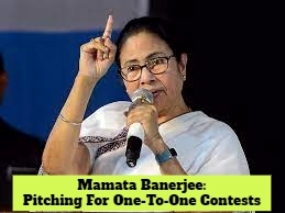

By Sunil Garodia
First publised on 2023-05-06 07:57:51
All persons desiring a goal look for the ideal way or situation to achieve them. The opposition parties in India, grappling to achieve unity against the BJP, are also looking for an ideal way to take on the BJP in the 2024 elections. Having been stream rolled by the BJP election machinery in two successive general elections in 2014 and 2019 and having seen the Modi government tightening the screws, the opposition is desperate to find a winning formula in the electoral math to beat the BJP on numbers. The ideal way is not difficult to find on paper. The BJP gets less than 40% votes nationally and less that 35% in many Lok Sabha seats that it wins. Hence, many opposition leaders are veering to the view that one-to-one contests, with the strongest opposition party in an area putting up its candidate against the BJP, is the ideal way to beat it.
On Friday, West Bengal chief minister Mamata Banerjee, who is trying to bring about opposition unity, made a strong pitch for the one-to-one, strongest party line. She said "all opposition parties should come together and fight the BJP one-to-one. Jo jidhar strong hai woh udhar ladiye. I have no objection to it, we should all try to work together". This ideal way, though good on paper and beneficial to strong regional parties like Banerjee's TMC, is not going to find truck with the Congress and some other parties that are trying to spread their wings nationally. In some states too, like UP where both SP and BSP can claim to be strong in an area, there will be problems putting up a joint candidate, although the voting percentage in the last Lok Sabh elections can be taken as the barometer to chose the party that will face the BJP.
But that will be a huge task given that all parties in the opposition are not on the same page. For instance, the AAP and the Congress will both claim to be the best opposition to the BJP in Gujarat, while the Congress and the CPM will claim the same in Kerala. There will be problems in other states too. Hence, there is no doubt that though one-to-one contests are the ideal it will not be easy to achieve. Further, given the caste and other calculations in many states, it will be difficult for the opposition to get some smaller caste-based parties to abstain from putting up a candidate and they will split the opposition votes. Further,it cannot also be guaranteed that transfer of votes from loyal voters of other opposition parties to the joint candidate will happen as desired. If the opposition can engineer one-to-one contests in even 80 percent of the seats, they will give the BJP a tough fight. But that looks a remote possibility as of now.











